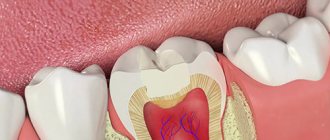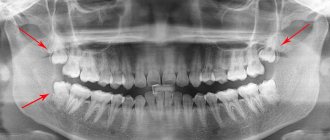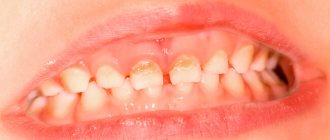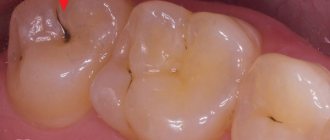Preparing for dental fillings
During the preliminary consultation, the dentist conducts a full examination of the dentition, during which he identifies the main areas of damage. In advanced cases, he may prescribe an x-ray of a separate area or an orthopantomogram to obtain a general picture of the condition of the dental canals.
Further preparation for filling comes down to hygienic procedures. If the damage prevents you from brushing your teeth normally using a toothbrush, it is recommended to rinse your mouth using bactericidal rinses. This will simplify the process of disinfecting the oral cavity in preparation for filling.
Sedation
“Calm, just calm!” This is the motto of anyone who crosses the threshold of a dental office. To do this, you can take a mild sedative (valerian, motherwort) or drugs with similar effects in advance (preferably after prior consultation with your doctor).
Anesthesia
It is mandatory if the teeth are damaged deeper than the enamel level. To do this, they mainly use injectable local anesthetics, which are injected into the area where the problem tooth is located. The start time for a standard injection drug is 15-20 minutes from the moment of administration.
If the damage extends only to the enamel, the treatment procedure does not require drug anesthesia of the nerve endings of the tooth, however, for people with hypersensitivity, as a rule, an exception is made.
In severe cases and with severe psychological instability, the patient may choose general anesthesia.
Clinic doctors
Your tooth has been filled. Finally! All fears and worries are left behind. It seems that you can breathe a sigh of relief and relax.
Then why do you feel discomfort, discomfort and pain in your filled tooth for several days? After all, a cured tooth should not hurt.
Unfortunately, despite modern materials and technologies used in dentistry, today pain after dental treatment is not uncommon. What is the reason?
Let's start with the definition →
What is post-filling pain?
Dental treatment is often accompanied by cleaning the canals, as well as the carious cavity of the tooth. Sometimes the nerve itself has to be removed and the canals filled. This is a serious intervention in the cavity and tissue of the tooth, so the appearance of minor pain after treatment is normal.
Post-filling pain occurs:
- at the moment of pressing on the treated tooth while chewing
- when the surface of a filled tooth comes into contact with the surface of another tooth
- when exposed to hot and cold irritants (hot tea, cold water)
The nature, intensity and duration of pain may vary. And it depends on what equipment, materials and preparations were used to treat the tooth. An important factor is the qualifications and experience of the dentist. The individual characteristics of the patient’s body play a big role.
However, if the tooth treatment was carried out correctly, post-filling pain disappears after a few days.
But if more time has passed and the pain does not subside, you need to determine →
Causes of pain after tooth filling
1. Incorrect treatment
Inappropriate treatment can lead to progression of the disease in the filled tooth. Moreover, it can provoke various complications.
Sometimes, after filling dental canals, processes remain that are not filled with filling material or the material, on the contrary, extends beyond the canal.
Then pain indicates the development of an inflammatory process.
Also, when the tooth cavity is not completely cleaned, fragments of enamel and pathological tissue may remain under the installed filling. The result is widespread inflammation.
In such situations, pain after filling is, alas, inevitable. And treatment is carried out only after a thorough diagnosis.
At the DentaBravo clinic, we offer patients an X-ray. With its help, the dentist will be able to determine the true cause of the pain and prescribe the correct treatment.
2. Incorrect filling
There are few patients who sit in the dental chair without fear and anxiety. Excessive nervousness of the patient during filling can interfere with treatment, especially if the doctor does not have sufficient experience.
In such cases:
- technology and work rules are violated
- Long-term drilling with a drill can cause overheating of the tooth and burn of the pulp
- improper etching of the enamel with its damage
After a short period of time, the tooth cavity may depressurize. This usually happens if the edges of the filling do not fit tightly to the walls of the tooth. Bacteria can get into the resulting gaps, which will lead to infection and pain.
3. Individual reaction of the patient’s body
Each person has their own physiological characteristics.
Therefore, sometimes our body reacts to a particular dental procedure unpredictably.
The cause of pain after filling can be an allergic reaction to medications and materials. Moreover, it will not necessarily be low quality material. Even high-quality and high-quality fillings can cause allergies.
Pain can be caused by prolonged acid etching of the dentin, which opens the dentin tubules. The filling material penetrates much deeper into the dentin layer, causing irritation of the pulp.
Usually, to eliminate temporary pain after treatment, it is enough to take painkillers for several days.
If your strength and nerves are exhausted by severe post-filling pain for much longer, DentaBravo specialists recommend seeking the help of a dentist as soon as possible.
Treatment of post-filling pain begins with accurately identifying its cause.
Even if you can guess what exactly led to the unpleasant consequences, only a specialist should determine the cause. As well as prescribing treatment.
This can be done if the dentist:
- will see the full picture of the disease
- finds out what dental treatment procedures you have had before
- will conduct a personal examination and take photographs
— all this is possible only during a visit to the clinic.
We will be glad if DentaBravo clinic becomes your choice.
DentaBravo clinic specialists will conduct a comprehensive diagnosis, select the most effective methods to solve this problem and draw up a treatment plan.
If necessary, the doctor will open the filling, carry out treatment and refill the tooth. If the cause of post-filling pain is an allergic reaction to drugs and materials, DentaBravo specialists will select another material and replace the old filling.
There is only one condition for the fastest and most painless solution to the problem: please do not self-medicate!
After all, only an experienced dentist can find out the cause of pain and promptly eliminate it. The sooner you contact a specialist, the sooner you will get rid of the pain.
Don't waste time!
Sign up for a free consultation at the DentaBravo clinic!
Dental filling procedure
Includes several sequential stages:
- Cleaning the damaged surface from unstable areas and carious formations. In the presence of caries, cleaning the surface is of particular importance: if the surface is not completely cleaned, tooth decay will continue even after the filling is installed.
- Drying of saliva in the working area is carried out using a saliva ejector and cotton swabs (or latex pads), which isolate the tooth from the surrounding soft tissue.
- Surface preparation includes mechanical and antimicrobial treatment. The latter is needed to increase the adhesion of the tooth surface to the finished filling composition. To do this, apply to a cloth cleaned with an antiseptic for 30 seconds. apply a special acid-containing solution. After washing off the solution, the cavity under the filling is thoroughly dried.
- Preparation of filling material and installation of the seal. At this stage, preparations are prepared in accordance with the purpose and type of filling. This can be either a therapeutic temporary filling or a durable composition with a 20-year service life. When installing a permanent filling, the paste is carefully compacted to avoid the formation of tiny bubbles, and after hardening, it is ground and polished to the level of the natural bite. As a result, the tooth acquires its natural shape and healthy functionality.
A tooth hurts after treatment: what to do?
If your tooth hurts a lot after treatment, and you don’t have an appointment with a specialist in the near future, you can try to cope with the pain yourself before your appointment. Below are the common methods:
- Rinse with a solution of salt and soda. This solution has an antiseptic effect, eliminates the inflammatory process, and reduces the severity of pain. To prepare it, add one spoonful of soda and salt to 250 ml of warm boiled water. Mix everything thoroughly. Rinse your mouth with the resulting solution for 5 minutes 3-4 times a day.
- Rinsing with a decoction of medicinal plants. Chamomile (has antibacterial and anti-inflammatory effects), sage (relieves inflammation, eliminates pain) are excellent. To prepare the decoction, take one tablespoon of raw material, add hot boiled water and leave to infuse for 30–40 minutes. The resulting solution is filtered and used for rinsing at least 2 times a day.
- Lotions with essential fir oil. Essential fir oil has an analgesic and anti-inflammatory effect. To get rid of toothache, just put 5 drops of fir oil on a piece of bandage or cotton wool and apply it to the painful tooth for 10-15 minutes.
- Applying a product with cloves and oil. Cloves have antibacterial properties and relieve pain well. To prepare the product, two cloves are crushed, mixed with a small amount of vegetable oil. The result is an anesthetic that is applied to the painful area for a few minutes.
- Taking non-steroidal anti-inflammatory drugs. Among pharmaceutical drugs, Ketoprofen, Nise, and Ibuprofen are in particular demand. Take strictly as indicated in the instructions.
It is important to note that some natural ingredients can cause allergic reactions, so you should be careful. If unpleasant sensations occur (for example, itching or burning), the procedure should be stopped.
Channel processing
During deep treatment, filling the dental canals deserves special attention. To do this, the pulp filling it is completely removed, the walls are thoroughly cleaned and ground. This process may take several trips to the doctor and require the installation of a temporary filling.
After treating the cavity with antibacterial compounds, it is filled with a filling mass. If the work is done well, the x-ray should show 100% filling of the entire cavity.
Canal treatment methods
- Depophoresis allows you to qualitatively sterilize the cavity of the dental canal in the presence of cracks, pathological cavities and curvatures. The sterilizing drug is administered using a special instrument that penetrates into the most inaccessible areas of the canal.
- Filling with gutta-percha (cold or hot method) is a simple and reliable solution for filling standard-shaped canals.
- Mummification is the introduction of shock doses of an antiseptic into the pulp area, which completely eliminates the possibility of an inflammatory process.
- Retrograde filling is used in the presence of a special gun with a nozzle, which makes it possible to fill the cavity better.
Advantages of visiting Dr. Martin dentistry
If you have a severe toothache after treatment, just contact Dr. Martin dentistry. Only experienced, highly qualified specialists work here. They will conduct an examination,, if necessary, prescribe a diagnosis to determine why the tooth hurts after treatment, and immediately solve this problem. In their work, doctors use only proven techniques and reliable modern equipment.
Numerous positive reviews from patients confirm the high quality of the services provided. At the same time, the cost of the procedures is affordable (you can find out more about the price list on the website). Free consultations are available to each patient. To make an initial appointment with a specialist at Dr. Martin dentistry, just call the phone number provided or fill out a standard form online, indicating your contact information - name and number.
Filling material
There are two main types of fillings used in dentistry: temporary and permanent.
Temporary fillings are installed for diagnostic and therapeutic purposes for several days or weeks. They are used to preserve dental pulp, restore dentin, relieve inflammation or eliminate the dental nerve using special chemical compounds.
A permanent filling is placed with the expectation of long-term service and is designed to completely restore the functionality of the tooth and its aesthetics (especially important for the front incisors).
Types of fillings:
- by material composition (cement, metal, composite, photopolymer, compomer, ceramic);
- according to the method of hardening (light, chemical hardening);
- at the place of application (for the coronal part, when filling canals).
The most important thing is the choice of filling material.
Cements are the most affordable materials. They are used less and less often for filling permanent teeth, but the content of fluoride ions in some compositions makes them relevant for protecting against recurrent caries of both milk and permanent teeth.
Metal fillings (amalgams) are alloys based on various metals (silver, copper, mercury). Such materials do not perform an aesthetic function, therefore they are used for filling only molars, but they are quite wear-resistant and affordable.
Composite and photopolymer materials are the optimal choice of modern dentistry. Unlike cement, they allow you to create reliable, long-lasting fillings. Unlike amalgam material, they combine well with natural fabrics.
The top of the range of filling materials are ceramic and compomer fillings - the most expensive, but most durable samples. They do not shrink and are able to completely merge with tooth tissue without changing color over time. Non-toxic, do not destroy tissue and do not require special care.
What to do if the pain during dental canal treatment is unbearable
If there is a lot of pain after root canal filling, you should take a painkiller and immediately contact the doctor who provided the dental service. He knows how the treatment went and will advise the best way to solve the problem:
- Supplemental anesthesia: Used when standard anesthesia is ineffective. A stronger analgesic may be prescribed (for example, nimesil instead of Nurofen) and a tampon with the drug may be applied for several days.
- Changing treatment tactics: an initially incorrect diagnosis without taking into account the clinic, incomplete history taking, diagnosis, examination of the patient and the carious cavity lead to the wrong choice of treatment method. This is not always a doctor's mistake. Complications may develop as a result of exposure to factors of a different nature (pre-existing diseases, low body resistance, injury, individual reaction, etc.).
During the re-examination, a new treatment regimen will be developed to eliminate pain and its causes. It may be necessary to refill unsuccessfully made tooth canals.










